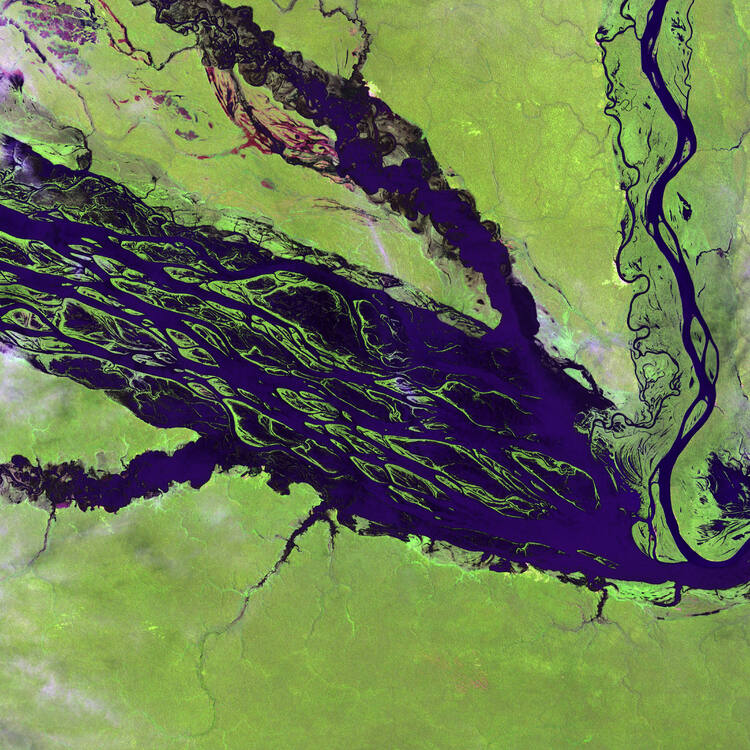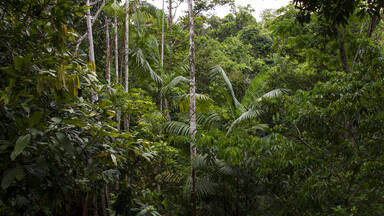Central Amazon Conservation Complex
Central Amazon Conservation Complex
The Central Amazon Conservation Complex makes up the largest protected area in the Amazon Basin and is one of the planet’s richest regions in terms of biodiversity. It also includes an important sample of varzea ecosystems, igapó forests, lakes and channels which take the form of a constantly evolving aquatic mosaic that is home to the largest array of electric fish in the world. The site protects key threatened species, including giant arapaima fish, the Amazonian manatee, the black caiman and two species of river dolphin.
Description is available under license CC-BY-SA IGO 3.0
Complexe de conservation de l’Amazonie centrale
Ce site forme la plus grande zone protégée du bassin amazonien et l’une des régions les plus riches de la planète sur le plan de la biodiversité. On y trouve notamment un exemple significatif d’écosystèmes de varzea, des forêts d’igapó, des lacs et des cours d’eau qui forment une mosaïque aquatique où évolue la plus grande diversité de poissons électriques du monde. Le site abrite des espèces menacées d’une importance cruciale, notamment l’arapaima géant, le lamantin de l’Amazone, le caïman noir et deux espèces de dauphins d’eau douce.
Description is available under license CC-BY-SA IGO 3.0
مجمّع حفظ منطقة الأمازون الوسطى
يشكّل هذا الموقع الذي تفوق مساحته ٦ ملايين هكتار أكبر منطقة محمية في الحوض الأمازوني وأكثر المناطق الطبيعية غنىً في العالم على صعيد التنوع البيوليوجي. ويضم بشكل خاص عيّنات مهمة من أنظمة الفارزيا البيئية، وغابات الإيغابو، والبحيرات ومجاري المياه التي تؤلّف فسيفساء مائية حقيقية تشكل مرتعاً لأكبر سرب من الأسماك الكهربائية في العالم. كما يوّفر هذا الموقع ملاذاً آمناً لأجناس مهمة جداً ومهددة بالإنقراض، لا سيما سمك البنجاسيوس العملاق، وخروف البحر الأمازوني، والكيمان الأسود (نوع من التماسيح) وجنسين من الدلافين النهرية.
source: UNESCO/CPE
Description is available under license CC-BY-SA IGO 3.0
亚马逊河中心综合保护区
亚马逊河中心保护区占地超过600万公顷,是亚马逊盆地中最大的保护区,同时也是地球上生物多样性最丰富的地区之一。保护区内还有平坦耕地生态系统、洪泛森林生态系统,以及湖泊和河流的重要范例,多种水生动物不断进化,这里成为世界上最大的发电鱼类种群的栖息地。保护区为许多珍稀濒危动物提供保护,例如巨骨舌鱼、亚马逊海牛、黑凯门鳄和两种淡水豚类。
source: UNESCO/CPE
Description is available under license CC-BY-SA IGO 3.0
Комплекс резерватов Центральной Амазонии
Этот крупнейший во всем бассейне Амазонки комплекс охраняемых природных территорий с точки зрения биоразнообразия – один из богатейших регионов на планете. Здесь представлены такие экосистемы, как «варзея» и «игапо», а озера и протоки формируют мозаичную и находящуюся в состоянии постоянного развития аква-систему, которая служит местообитанием для самой крупной в мире популяции электрического угря. К числу редких и исчезающих видов относятся амазонский ламантин, черный кайман, два вида речных дельфинов, а также рыба – гигантская арапаима.
source: UNESCO/CPE
Description is available under license CC-BY-SA IGO 3.0
Complejo de conservación de la Amazonia Central
Este sitio es la zona protegida más vasta de la cuenca del Amazonas y una de las regiones del planeta de más rica biodiversidad. Ofrece una muestra significativa de ecosistemas de varzea, bosques de igapó, lagos y ríos que forman un mosaico acuático donde vive la mayor variedad de especies de peces eléctricos del mundo. Además, el sitio alberga otras importantes especies animales en riesgo de extinción, por ejemplo el arapaima gigante, el manatí del Amazonas, el caimán negro y dos tipos de delfines fluviales.
source: UNESCO/CPE
Description is available under license CC-BY-SA IGO 3.0
中央アマゾン保全地域群
ジャウー国立公園はアマゾン川流域最大の国立公園で、地球上最も豊かな生態系をもつ地域の一つである。1986年にジャウー川の全水域を保護するために設立され、面積は、227万2000haにおよぶ。ジャウー川はブラックウォーター生態系(有機物の分解や堆積物の不足による水の色によって名づけられた)の典型として知られる。この国立公園はジャウー川の水流域のみならず、ブラックウォーター生態系に関連する生態系の大半が保護対象。source: NFUAJ
Beschermd Centraal-Amazonegebied
Het beschermd Centraal-Amazonegebied is het grootste beschermde gebied in het Amazonebekken en kent een bijzonder rijke biodiversiteit. Het omvat jaarlijks overstroomde (varzea) ecosystemen, igapó bossen, meren en kanalen die samen een voortdurend evoluerend watermozaïek vormen, dat de thuisbasis is van de grootste reeks elektrische vissen ter wereld. Het gebied beschermt verschillende (bedreigde) diersoorten, die veelvuldig voorkomen in zwartwaterrivieren. Onder de zeer bedreigde diersoorten vallen de reuze arapaima, de Amazone zeekoe, de zwarte kaaiman en twee soorten rivierdolfijnen. In totaal komen er 120 soorten zoogdieren, 411 vogelsoorten, 15 reptielensoorten en 320 vissensoorten voor in dit beschermde gebied.
Source: unesco.nl
Outstanding Universal Value
Brief description
This site of more than 6 million hectares is the largest protected area in the Amazon Basin and one of the richest areas of the planet in terms of biodiversity. First, Jaú National Park was inscribed in 2000. The property was subsequently expanded in 2003 with the addition of three other protected areas (Anavilhanas National Park, Amanã Sustainable Development Reserve, and Mamairauá Sustainable Development Reserve). The classification of these four sites developed into the current property entitled Central Amazon Conservation Complex.
Located primarily at the confluence of the Negro and Solimões Rivers, the property contains the majority of the ecosystems recorded in the Amazon, including dryland forests and periodically flooded lowland forests (várzea and igapó, as well as black-water or white-water watercourses, waterfalls, swamps, lakes and beaches. The Anavilhanas Archipelago, one of the largest river archipelagos in the world, is constantly evolving and is home to the largest array of electric fish on the planet. The site protects a wide variety of flora and fauna, including rare and endangered species such as the giant Arapaima (the largest freshwater fish in South America), the giant otter, Amazonian manatee, the black caiman and two species of freshwater dolphins.
Criterion (ix): The várzea and igapó flooded forests, lakes, rivers and islands of the site demonstrate ongoing ecological processes in the development of terrestrial and freshwater ecosystems. They include a constantly changing and evolving mosaic of river channels, lakes, and landforms. In constant movement, the floating mats of vegetation typical of the várzea watercourses include a significant number of endemic species and the largest array of electric fishes in the world. Anavilhanas contains the second largest river archipelago in the world, much better preserved than the larger Mariuá Archipelago, located in the same river upstream of Anavilhanas. It illustrates the process of colonization and evolution of the vegetation on changing landforms.
Criterion (x): The property protects a large and representative sample of the flora and fauna of the forests of the Amazon Central Plain, with a significant number of terrestrial and aquatic ecosystems associated with the forest which are periodically inundated by seasonal flooding, as well as swamps. Known as one of the largest Endemic Bird Areas and also as a Centre of Plant Diversity, the property protects an impressive variety of flora and fauna species of which around 60% of the fish species living in the Negro River watershed, and 60% of the birds recorded in the Central Amazon region. Characterized by a high degree of endemism, much of the wildlife is nocturnal. The property represents one of the most diverse regions for primates, with endangered species such as the bald uakari (Cacajao calvus) and black squirrel monkey saimiri (Saimiri vanzolinii) and some endangered water species as the giant otter (Pteronura brasiliensis), the Amazonian manatee (Trichechus inunguis) and the black caiman (Melanosuchus Niger). Other notable species are the golden-backed black uakari (Cacajao melanocephalus), yellow caiman (Caiman crocodilus), jaguar (Panthera onca) and harpy eagle (Harpy harpyja), the last two being "near threatened" according to the IUCN Red List. The “pirarucu” (Arapaima gigas), the largest freshwater fish in South America, and two species of river dolphins (Inia geoffrensis and Sotalia fluviatilis), all three with a "data deficient" status, are also found in the property. In addition, 64 species of electric fish, which is the strongest known diversity for this group unique in the world, with a circulation range and an adaptation rate comparable to those of cichlids in the African Rift Valley, have been identified in the property
Integrity
The dimensions of the property are sufficient to maintain important ecological and biological processes, such as chablis, fluctuations in the dynamics of flooding and wildfires, which offers unique opportunities to study their effects on biodiversity in natural ecosystems. The dryland forests which constitute a large part of Jau and Amanã are virtually pristine wilderness areas covering millions of hectares.
The site has an excellent degree of conservation in terms of biodiversity resulting from the territorial scope of the property and the protective effect generated by the ecological corridor formed by protected areas. The boundaries of the property are mostly naturally defined by the rivers of the region and enclose large areas where anthropogenic impact levels are low. However, some of them, with a few thousand people whose survival depends on the exploitation of natural resources, do not have protection or active management It is important that all necessary measures be taken to ensure the conservation of the unique ecosystems of the region and the sustainable use of their resources, in cooperation with the stakeholders. There is no future development project that could compromise the integrity of the site.
Protection and management requirements
Protected areas that are part of the Central Amazon Conservation Complex were created at distinct periods: the Jaú National Park in 1980, the Anavilhanas Ecological Station in 1981 (relisted as a National Park in 2008), the Mamirauá Sustainable Development Reserve in 1990 and the Amanã Sustainable Development Reserve of in 1998. The National Parks are managed by the Chico Mendes Institute for Biodiversity Conservation (ICMBio), an autonomous federal agency under the Ministry of Environment. The Sustainable Development Reserves are linked to the State, and managed by the Amazonas State Conservation Units Centre (CEUC). With the exception of the Amanã Reserve, the other three protected areas have a management plan. The availability of technical, human and financial resources is essential to consolidate the management of the property.
In order to ensure a participatory management as stipulated in the Brazilian legislation, National Parks have advisory boards for their operation, and the Sustainable Development Reserves have legislative councils. It is important to continue to involve indigenous people in the management of the property, while recognizing that this is a long-term activity. The needs related to international tourism and those of research require Jaú and Mamirauá to have well-defined public use plans.
To ensure the conservation of the protected areas, protection plans are implemented by the various responsible agencies. Scientific research and environmental education activities are encouraged and developed in the Complex. All protected areas of the property are also part of the Biosphere Reserve, which comprises, with other areas, the "Mosaic of Protected Areas of the Lower Rio Negro." The whole is integrated into an extensive regional ecological corridor programme, within environmental programmes and policies designed to guarantee integration of the management and conservation of this vast portion of the Amazon biome.

 View photos from OUR PLACE the World Heritage collection
View photos from OUR PLACE the World Heritage collection
